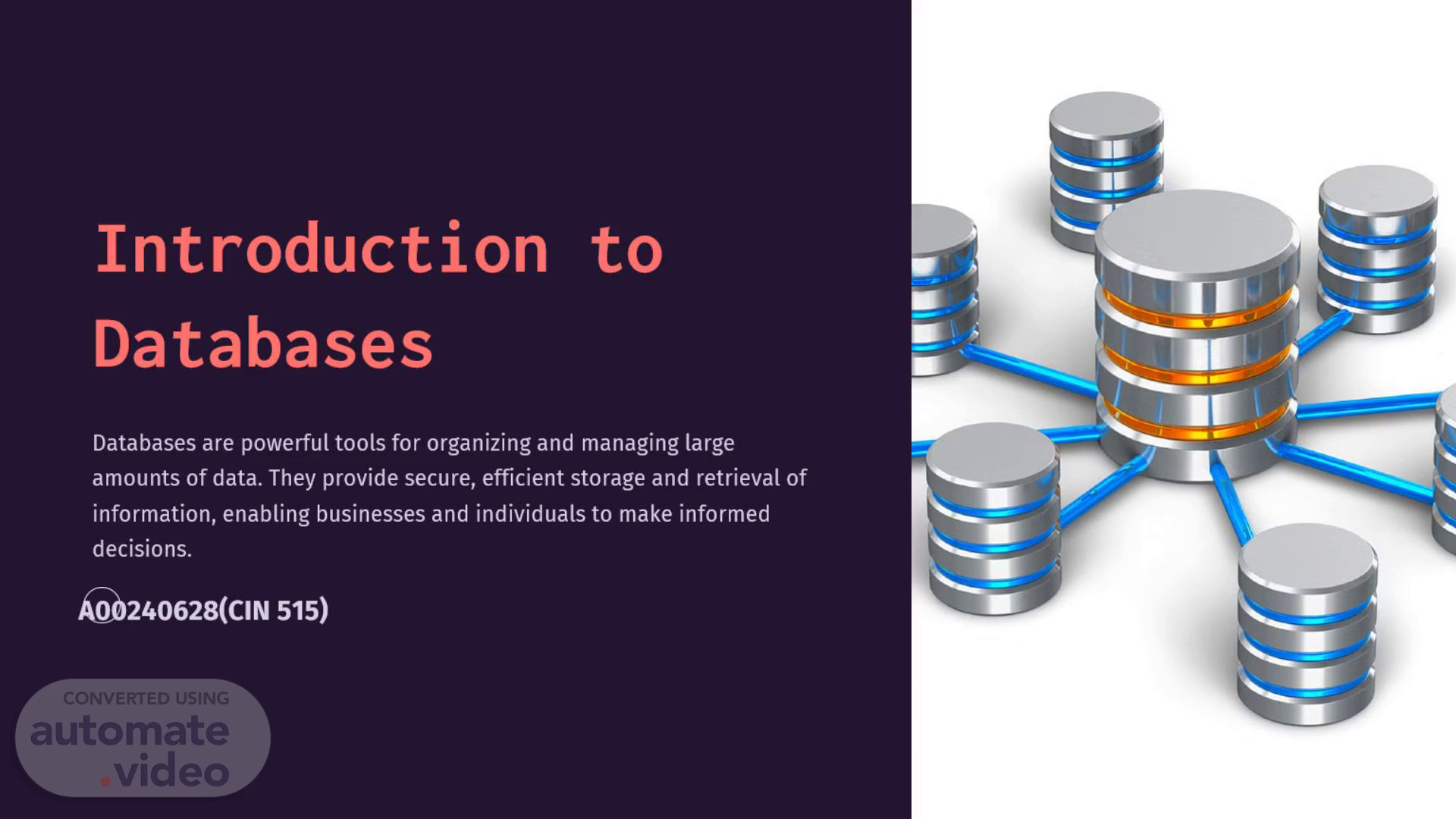
PptxGenJS Presentation
Scene 1 (0s)
[Audio] Introduction to Databases Databases are powerful tools for organizing and managing large amounts of data. They provide secure, efficient storage and retrieval of information, enabling businesses and individuals to make informed decisions. A00240628(CIN 515).
Scene 2 (21s)
[Audio] What is a Database? Data Repository Organized Storage Powering Applications A database is a structured collection of data that is organized and stored in a way that allows for efficient retrieval, management, and manipulation of information. Databases use a variety of data models, such as the relational model, to define the structure and relationships between data, enabling efficient storage and access. Databases serve as the backbone for a wide range of applications, from e-commerce websites to enterprise resource planning (ERP) systems, providing the necessary data to power these systems..
Scene 3 (1m 0s)
[Audio] Database Management Systems (DBMS) Data Storage Data Querying Data Security A DBMS provides a centralized and organized way to store and manage data, ensuring data integrity and security. DBMS allow users to efficiently retrieve, manipulate, and analyze data using specialized query languages like SQL. DBMS implement access controls, user authentication, and backup/recovery mechanisms to protect data from unauthorized access and loss..
Scene 4 (1m 33s)
[Audio] Database Models Hierarchical Model Network Model Relational Model Object-Oriented Model An evolution of the Hierarchical model, allowing more flexible many-to-many relationships between data. Uses a graph-like structure with records and connections, providing greater flexibility but more complexity. Data is stored in tables with rows and columns, allowing complex relationships to be modeled using keys. Widely used, with a strong mathematical foundation and powerful querying capabilities through SQL. Data is organized in a tree-like structure, with a root node and child nodes in a parent-child relationship. Useful for representing one-to-many relationships, but rigid and can be difficult to model complex data. Data is represented as objects with properties and methods, mirroring real-world entities. Allows for encapsulation and inheritance, making it well-suited for complex, dynamic data, but can be more challenging to query..
Scene 5 (2m 35s)
[Audio] Relational Database Concepts Tables and Rows Primary and Foreign Keys A relational database organizes data into tables, where each row represents a unique entity and the columns define the attributes of that entity. Primary keys uniquely identify each row, while foreign keys link data between related tables, establishing relationships within the database. Schema and Normalization Transactions and ACID The database schema defines the structure, including tables, fields, and relationships. Normalization ensures the schema is optimized to minimize data redundancy and improve integrity. Transactions guarantee that database operations are processed reliably and consistently, following the ACID principles of Atomicity, Consistency, Isolation, and Durability..
Scene 6 (3m 26s)
[Audio] SQL (Structured Query Language) Data Manipulation Data Definition SQL enables you to create, update, and delete data within a database using powerful commands like SELECT, INSERT, UPDATE, and DELETE. With SQL, you can define the structure of a database, including tables, columns, data types, and relationships, through statements like CREATE, ALTER, and DROP. Data Query Data Control The SELECT statement allows you to query the database and retrieve specific data that meets your criteria, enabling powerful data analysis. SQL provides mechanisms for controlling access and permissions to the database, ensuring data security and integrity through features like GRANT and REVOKE..
Scene 7 (4m 20s)
[Audio] Database Design Principles Identify Requirements Thoroughly understand the business needs and user requirements to design an effective database structure. Conceptual Design Create a high-level data model that represents the entities, relationships, and constraints of the system. Logical Design Translate the conceptual model into a detailed logical schema using a data model like the relational model. Physical Design Optimize the logical schema for performance by selecting appropriate data types, indexes, and storage configurations..
Scene 8 (4m 56s)
[Audio] Data Normalization 1NF: Eliminate Repeating Groups Ensure each table has a primary key and that all attributes are single-valued, not groups of related data. 2NF: Eliminate Partial Dependencies Remove attributes that are dependent on only a part of the primary key, creating separate tables. 3NF: Eliminate Transitive Dependencies Identify and remove attributes that are not directly dependent on the primary key, placing them in separate tables..
Scene 9 (5m 28s)
[Audio] Database Security and Backup Safeguarding Data Integrity Disaster Recovery Planning Compliance and Regulations Monitoring and Incident Response Robust database security measures, including access controls, encryption, and regular security audits, are crucial to protecting sensitive information from unauthorized access or malicious attacks. Adhering to industry-specific data privacy and security regulations, such as GDPR or HIPAA, helps organizations maintain data integrity and avoid costly penalties for non-compliance. Comprehensive backup strategies and disaster recovery plans ensure that data can be restored in the event of hardware failures, natural disasters, or other emergencies, minimizing downtime and data loss. Continuous monitoring of database activity and the implementation of incident response procedures enable quick detection and mitigation of security breaches, reducing the impact of potential threats..
Scene 10 (6m 30s)
[Audio] Trends and Future of Databases Databases are evolving rapidly, driven by the explosion of data and the need for more efficient data management. Key trends include cloud-based databases, NoSQL databases, in-memory databases, and the rise of big data analytics. Looking ahead, databases will become more intelligent, self-managing, and scalable to handle the challenges of the digital age. Advancements in AI and machine learning will enable databases to optimize performance, secure data, and provide deeper insights..